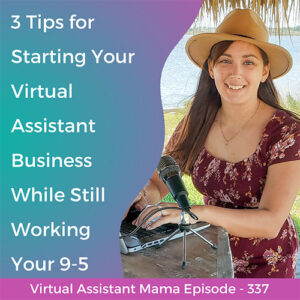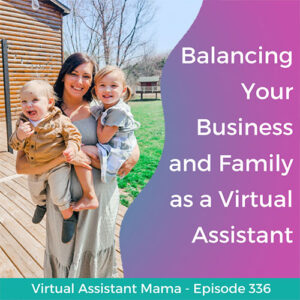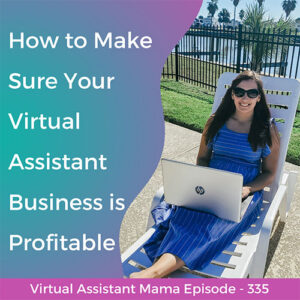
Episode 337: 3 Tips for Starting Your Virtual Assistant Business While Still Working Your 9-5
In this episode of the Virtual Assistant Mama podcast, I’m sharing 3 tips to help you start your Virtual Assistant business while still working your 9-5.
In this episode of the Virtual Assistant Mama podcast, I’m sharing part 2 of a 3-part series where I take you behind-the-scenes into what my Virtual Assistant business has looked like from the beginning until now.


Grab your Ditch the Classroom Toolkit for only $47!
Sign up for the free Virtual Assistant Workshop, the Ditch the Classroom Toolkit, or Teacher Turned Freelancer Academy.
Have any questions for me? Feel free to send me an email at arianna@ariannavernier.com or on Instagram @arianna.vernier! I love chatting with y’all and helping you hit the ground running. Are you ready? Let’s go.
Love,

Full Episode Transcription:
[00:00:00] Hey y’all, welcome back to part two of the behind the curtain of my business journey series. Just walking you through how I got started as a virtual assistant, what it looks like these days, how I’ve been able to be successful with this and how you can be too. So back in part one last Thursday, I just really talked about my journey from. Being a teacher, having my daughter, and then really diving full force into the virtual assistant world, how I was able to land clients, how long it took me to replace my income, and all of that.
[00:00:37] So if you haven’t listened to part one, go back and check that out. In this episode, part two, I really want to walk you through how I’ve been able to show up consistently and grow my business in the four years that I’ve been in this virtual assistant world. So I’m going to be sharing the three things that I did to build my business without sacrificing time with my family. Cause like I said, when I started this, I had a newborn daughter by my side. So I didn’t have a whole lot of time to give to my business after caring for her and our house and being a wife and all the things. So back in the last episode, we kind of ended off on me saying that it took me about six months to fully replace my teaching income. But honestly, At about the end of that six months, I wasn’t super, super happy with where I was at because I was still doing a lot of the social media management. I was just getting into doing website design for my clients, which I found that I really loved, but didn’t love the social media management part.
[00:01:46] And I just found myself really floundering, like, how do I let go of these clients that I’m not really lit up to serve anymore? And how do I really transition and niche down into something that does light me up, aka website snake. And really what kind of put the nail in the coffin, so to speak, is that I ended up having a client who expected me to do her social media stuff for her on Christmas Day. Now. Remember, I had just had my daughter that past June, so this was my first Christmas with a kid, and now I was expected to work. It wasn’t a ton of time that I was expected to work, but even being expected to get on my phone at all for a client on Christmas Day, I was like, this is not what I signed up for. I didn’t even have to work on Christmas. When I was a teacher, I’m not doing this in my own business. So that was kind of really when I was like, something’s got to change. I got to tweak something because this is not going to fly. I need to have very solid boundaries set up in my business, and I need to figure out ways that I can streamline my work and make sure that my work is on my own time, not my client’s time.
[00:03:10] And. Really build this business in as little time possible so that I could take time off whenever I wanted to Not be expected to show up on a certain day to do something and things like that So really there are three things That I did in order to pivot and, and start to build my business in the way that I wanted it to look. So this was at the same time as I was pivoting into website design and letting go of my social media clients, I was starting to implement. These three things we’re going to go into now. So the first thing I really started doing when I was shifting my business was I started time blocking. I got really consistent with using my paper planner. I have mentioned this on the podcast before. I use and love the Horatio, H-O-R-A-C-I-O planner. It’s called their Dream Planner, and it’s Christian-based. I love that there’s a ton of blank space in there so you can really make it exactly what you need for your life. And I also love that it has like your whole week laid out in like two pages so you can see it all at once.
[00:04:31] So. When I would sit down to do my planner every week, I would kind of block out, okay, what hours do I know that I’m going to be able to work? Like when my daughter’s napping, for example, I knew I’d have a good like solid two, maybe three hours in the middle of the day to work on my business. I knew I could do a power hour in the morning a couple days a week before she woke up. I knew that I had that one evening a week that I mentioned in the last episode where my husband was in charge of my daughter all evening, so I was able to get like a good solid five to six hours of work there. And then just, you know, that nap time and all that. So, I would look at my planner and map out exactly when I was going to be able to work, so I could just see at a glance and know, okay, this is when I’m going to be able to shift into that. Work mode because before I was just kind of you know floundering around not knowing when I was supposed to work Like I knew I could work during my daughter’s nap and like I’d maybe have this time and maybe have that time But it wasn’t something I could visually see so I always felt stressed of like, okay When’s when am I gonna be able to work next?
[00:05:43] So actually seeing it all laid out And seeing where white space was going to be in my day, where I knew I wasn’t going to have to work, where I knew I could just focus on my daughter and hanging out with my husband, that helped me so much to just take the stress out of my mind of like, Oh my gosh, I have all this stuff to get done. When am I going to get it done? So, this is something I’ve talked about a lot on the podcast. It seems like an extra step to get a planner and write things in, but one, it’s very calming to just sit and, like, handwrite something. And it doesn’t have to be perfect. I think a lot of people see a planner kind of like they do a budget that, like, Oh, when I write this down, I have to stick to this, or my whole week is just, like, out of sorts. And that’s not what I see it as. I see a planner And a budget as something that sets guidelines for you, but that can be adjusted based on what you actually need. So, yeah, I had a newborn. I didn’t always, you know, follow my planner to a tee because I had her changing up plans on me. But it just gave me that peace of mind to know, like, okay, if I need to shift something, where could I shift it to if something kind of goes awry?
[00:07:06] So that was really helpful. First off doing that time blocking in my planner. And then when I actually sat down to work, I needed to know exactly what I was going to be working on. I needed to have a game plan instead of just sitting down to work and being like, what am I supposed to work on today and not. Really focusing on the tasks that were actually going to make me money. So what I did is I ended up setting up a weekly workflow. When you have a business, there are tasks in your business that you do kind of on repeat a lot of times. So there’s some tasks that you’re only going to do once and then you’re never going to do it again. There’s some tasks that you’re going to do once a month. There’s some tasks you’re going to do once a week. And then there’s some tasks you’re going to do in your business daily. And so I wanted to map out those tasks that are recurring, whether it’s daily, weekly, monthly, yearly, and I wanted that mapped out so I wasn’t trying to, again, keep it all in my brain, and then it ends up getting lost.
[00:08:13] So, I set up a weekly workflow, and I did this using a program called Trello, T R E L L O. There’s other programs like this, there’s one called Asana, MeisterTask is another one, they’re all great. They all are pretty much the same, just have a little bit different, like, the way that they’re laid out. But for me, Trello was the one I went with because it just was the easiest to learn in the beginning. And so I just laid out Monday, Tuesday, Wednesday, Thursday, Friday, what tasks I had for those days. A lot of times they were just recurring tasks, so I would set the date. Ahead of time, I would change all the dates to that day of the week for the coming week. But then, like, once that week was done, I would just go into that task and change the date to, for example, the next Monday. So I didn’t have to retype that task every week. I just had to change the date on it, okay? So it just made it really easy for me to see exactly what I had to do every day that was recurring. And then, If I had a day where I didn’t have that many recurring tasks, that’s when I could focus on those tasks that I might, like, only do once and then never do again, more of those project based tasks. So, I set that up, and I do have for y’all a template of that. Free weekly planner, so you can grab that at ariannavernier.com/free-weekly-planner. That’s A-R-I-A-N-N-A-V-E-R-N-I-E r.com/free-weekly-planner. You can also find that link in the show notes, but that will help you. It’ll give you a foundation point to kick off on.
[00:09:59] And I do go a lot deeper into how to set up workflows and time blocks for your own business. Back in episode 65 here on the virtual assistant mama podcast. So you can go find that episode as well. If you need help getting this set up for yourself. Okay. So first thing I did was I started time blocking in my planner consistently. Second thing I did was I set up weekly workflows so I knew what I was doing when I sat down to work. And then the third thing that I did was I set up a client management system. So that all of my client communication was pretty much in one spot and it really streamlined the process for me. Before, I was using all the free resources, which is great when you’re starting out, but it’s really time consuming when you’re using this program to send a contract, and this program to send an invoice, and this program for something else.
[00:10:56] And it just, it got so overwhelming. And so I really streamlined that process so that I could spend a lot less time on admin work and a lot, a lot more of my work time just focusing on the actual client projects, and I streamline that process by getting a client management system. Now, I personally use Dubsado, D U B S A D O. Absolutely love them. They are a little pricey. So, if you’re first, you’re just starting out, like, use the free programs, that’s totally fine. But, once you’ve landed a couple clients and you’ve got a little bit of consistent income coming in, I cannot recommend Dubsado enough. It allows you to send invoices, contracts, forms, you can have people book a discovery call with you through there, you can set up your calendar in there for the times you’re available, and when you’re not, you can Email your clients through there, and then you can get their response in there as well. It seriously has so many capabilities, things that I don’t even fully use yet, and I’ve been using it consistently for over three years, and I could still use it for more that I don’t. So, it It’s amazing. All of the abilities that it has. And like I said, it just saved me so much time and energy because there’s literally already templates plugged in there for me. So when I have a contract, I need to send to a client. All I do is I go in and I edit a few couple little spots and I hit send.
[00:12:29] I don’t have to, you know, reformat and do all that stuff like I used to have to doing the free programs. And then with an invoice, I just really quickly go in, I select my package I already have created, might tweak a few things if I need to, and then I send it. Okay, it’s so, so, so easy. I do have an affiliate link that you can use and get a discount on Dubsado, and you can find that on my resources page at ariannavernier.com/resources or just go to my website ariannavernier.com and click on the resources tab at the top and it’ll have that linked there for you.
[00:13:06] All right, so real quick, let me recap the three things that I did to build my business To the point that I wanted it to, and still allowing me to spend as much time as I could with my daughter. Like, this really, I was still working 15 to 20 hours a week, but I was able to do so much more work. In that amount of time because of the things I did to streamline my business and I was really able to scale my income through these processes. So number one was time blocking consistently in my planner. Number two was having that weekly workflow that I was working from and then number three was having that client management system. Okay. So I hope this episode was helpful for y’all. Make sure you tune back in for part three, where I’ll be sharing the exact strategies that I used to grow my virtual assistant business, to consistently land new clients and all the things. So I can’t wait to see you guys back here on Thursday for part three, and I hope you have a great rest of your week.

In this episode of the Virtual Assistant Mama podcast, I’m sharing 3 tips to help you start your Virtual Assistant business while still working your 9-5.

In this episode of the Virtual Assistant Mama podcast, I’m sharing how to balance your business and family life as a Virtual Assistant.

In this episode of the Virtual Assistant Mama podcast, I’m sharing how to make sure your Virtual Assistant business is profitable.